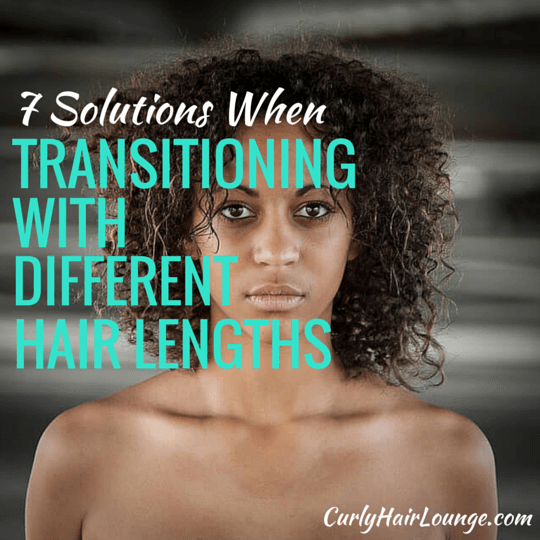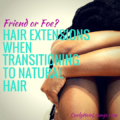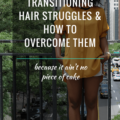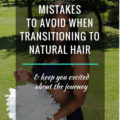It must be some kind of sick joke that fate is playing on you. It has to be! How come that when you decide to go natural and healthy your hair is breaking off with you? Literally!! Of course, you hear about the possibility of heavy breakage when transitioning to natural hair, but you never really believed that it could happen to you. Could this be you examining your hair in front of the mirror with surprise and disbelief? Fear not, my fellow transitioner, you are not alone, this happens to many on this journey and there are a few things you can to remedy your situation if you’re transitioning with different hair lengths.
1| Have A Trim
This may not be what you’re expecting to hear from me, but this is the best first thing you can do to address this issue. I know what you’re thinking girlfriend. We all want to maintain that length for as long has we can until our BC (big chop) day but, believe me, you do want to still have it there when the day comes.
Trimming your hair will even out its length and make it look more presentable, you don’t want to be walking around like a five-year-old child just cut your hair. Additionally, having a trim will also give you the chance to get rid of some brittle hair and split ends, which will make your hair more resilient and possibly avoid further breakage. You gotta trim to achieve hair health!
2| Deep Condition
Are you deep conditioning for protein and moisture on a regular basis? This is a very important step in your hair regimen, especially on a journey like this. You need to find a balance between the two treatments and stick to it. Protein will strengthen your hair’s internal structure and moisture will keep it hydrated, soft and manageable.
If you feel your hair is limp and dull it may need some protein. If, on the other hand, it breaks very easily you need some moisture (do a simple elasticity test). Don’t go all crazy one way or the other. My advice would be for you to try one treatment and see if your hair improves. If there is no improvement stop and try the other deep conditioning treatment. Once you feel your breakage has decreased significantly (there will always be some!) do your protein treatments maybe once or twice a month. You know your hair best, you make the call.
3| Do Protective Hairstyles
If you’re not doing these already then this is the perfect time for you to start. Protective hairstyles will keep the ends of you hair tucked away and protected from manipulation, the weather or your clothes. It helps to prevent breakage and retain hair length.
“Oh, but Mónica I like wearing my hair out and feeling it’s length. I don’t want to have my hair kept away all the time.” Well, though luck my friend! What you are experiencing is an extreme situation (excessive breakage), and while you could be getting away with low manipulation styles (twist outs/braid outs and such), you need to play all your cards to win this battle. Don’t worry, once your situation improves you can relax a little on the protective styles.
4| Watch Your Wash Day
If you’re washing your hair all in one go, you are causing yourself, and your hair, more problems than you know. Doing this will create further tangles and make you will lose your patience as you try to force your way into the tangles and knots, which will increase the problem and create breakage.
Divide your hair into sections and work through each one. Take your time, don’t rush it. Use your fingers or a wide tooth comb to detangle your hair, this will let you have more perception of the areas you need to be more gentle.
I too would like my wash day to last less than it does, but we need have to it nail it in our heads that our natural hair is different. Now, our new hair likes us to take our time with it, it likes to be caressed and pampered, it doesn’t want a quick and hollow relationship. I promise you that if you’re in this relationship for the long run and if you mean it your hair will respond back.
5| Use Your Satin Bonnet or Pillowcase
Rubbing your hair against a cotton pillow case will remove all the moisture and natural oils your hair has. What happens is your hair will get dry and will start to look dull, feel dry to the touch and you’ll also start noticing that it’s brittle as your ends start to split and break. Who knew that this mayhem could be happening to your hair while you are sleeping if you don’t take the right precautions?
To avoid this scenario, make sure you are using a satin pillowcase or bonnet to protect your hair. Alternatively, you can make a pineapple (a really high ponytail) and wrap a satin scarf around your head.
6| Avoid Certain Hair Accessories
Certain hair accessories have the ability to involve you in a tug of war with your hair. You may get some biceps out of it, but you will lose some hairs strands too, and the end result is not worth it. Certain accessories with metal, such as french metal clips, can trap your hair in it and snag and break it.
But, even your regular hair scrunchie can cause you breakage. If a bun or ponytail is your go-to style, know that your cotton scrunchie is sucking your hair’s moisture, and doing the same style over and over again are causing an indentation mark on your hair that makes it vulnerable to breakage. Try using a satin scrunchie and change up your bun or ponytail’s position. Finally, if you like using hats and beanies make sure they are satin lined to avoid further moisture loss and hair breakage. A satin lined beanie will help to keep your hair moisturised and protected.
7| Apply Hair Extensions
Hair extensions are a good way to give your hair and yourself a break from your hair transition and its demands. Don’t get me wrong, I believe that it’s best to experience our hair throughout our transitioning journey so we “know” what it asks of us when the time comes to wear our natural hair out.
However, I also believe that sometimes it’s necessary to take a break, rewind and reset so we can figure out what we are doing wrong and what can be improved. Hair extensions will give you this breathing time, so you don’t feel you’re chasing something and always falling. Your relationship with the extensions doesn’t have to be a friend or foe one. You just need to know what you’re doing.
Nevertheless, if this is your chosen way to address your transitioning hair breakage I want you to know that this is not a green card to completely forget about your hair. Yes, your hair is still somewhere in there, underneath your extension and it still needs to be taken care of.
These are my tips on how you can address different hair lengths when transitioning in case it’s something you’re going through or, God forbid, ever happens in the future.
Let me know what you are doing, or did, to get around this problem while transitioning!







